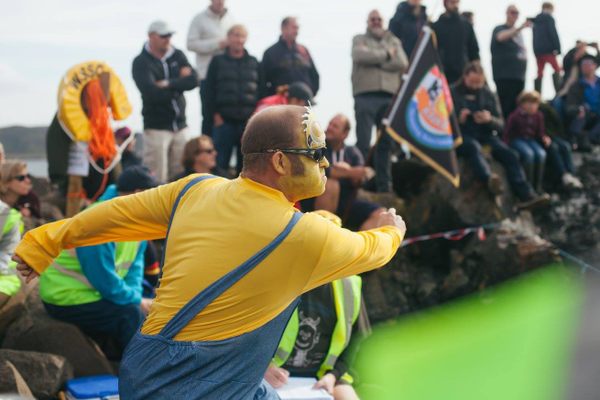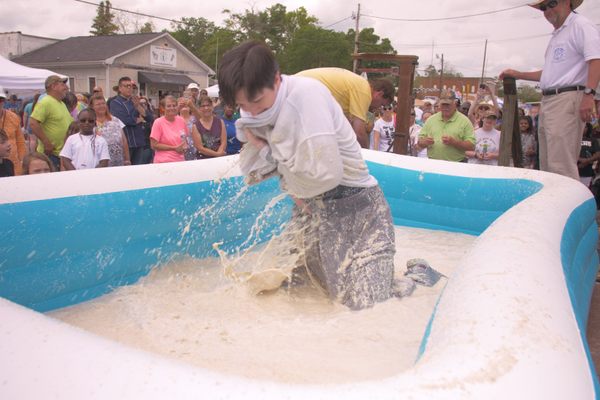The Wet and Wild World of Underwater Sports
Sure, rugby is fun on land, but why not play it at the bottom of a swimming pool?

Say hello to underwater football. (Photo: Abraham Essenmacher/Public Domain)
Imagine lying on your back on top of a basket at the bottom of a swimming pool. A fellow in snorkeling gear is trying to dislodge your butt from its position, and you’re starting to run out of air.
You are in the watery midst of a game of underwater rugby.
In each match, two keepers take turns lying across a basket secured at the bottom of the pool in which players must score, employing a constant switcheroo to replenish their lungs. In order for the players on the other team to score, they need to get under the goalie’s buttocks, push up with one arm, and slip the salt-water-filled ball underneath the goalie’s outstretched body and into the basket.

Some German women get serious with underwater rugby. (Photo: Petter F. Schmedling/CC BY-SA 3.0)
“One of the skills we train and practice is how to score,” explains Tim Leslie, a 35 year-old Aussie who’s been playing the sport since he first encountered it in 2007. “Head end? Butt end? How do you lift them up? Push? Pull? The most effective way to get rid of the defender on the basket is to swim, lift the guy up, and put the ball in.”
Underwater rugby, which started appearing in Germany in the 1960s, belongs to a growing field (or should we say pool) of athletics governed by the Confederation Mondiale des Activités Subaquatiques (CMAS), a European organization that Leslie says takes itself very seriously. All of these subaquatic sports have at least one thing in common, aside from being underwater: the importance of being able to hold your breath.

Things can get dicey down around the rugby basket. (Photo: unswuwr/screen shot)
Leslie says that his team in Sydney played a group from New Zealand that included a free diving champion, who would just sit at the bottom of the pool for three to four minutes at a time, and wait with the ball until everyone swam up for air. But Leslie also says that the 100 or so players in Australia are novices—in certain South American and Nordic countries, underwater rugby is massive. When an exchange student comes from a country like Colombia, which hosted the 2016 Underwater Rugby World Cup, it’s like an American college football player coming and schooling them in Australia’s version of the NFL. In Colombia, underwater rugby is so popular, you can watch it on TV.

Both men and women partake in aquathlon. (Photo: Alina Tsivkin/screen shot)
Underwater rugby has very little in common with what Leslie now calls “land rugby,” aside from abundant tackling. (Regarding drowning concerns, there’s a key rule: if you drop the ball, everyone has to let go of you so you can get to the surface.) But take out the baskets and teams, and you’ve basically got underwater wrestling—which is also an official sport governed by CMAS. It’s called aquathlon.

It looks difficult. (Photo: aquathlon.flv/screen shot)
In aquathlon, which CMAS describes as “a martial art and combat sport,” two opponents each try to remove a ribbon from the other’s ankle band within a 16-square-foot ring in a swimming pool. This happens over three 30-second rounds, giving participants an intense but mercifully brief cardio workout. Aquathlon originated in the former USSR, and St. Petersburg, Russia hosted the first Aquathlon World Cup in 2009. (Just so we’re clear, this version of aquathlon is different from another type of “aquathlon” in the U.S., which is basically a triathlon without the bicycling component.)

These underwater hockey players are even wearing underwater hockey gloves. (Photo: DavidUnderwater/CC BY-SA 3.0)
Going back to team sports, there’s also underwater football and underwater hockey, which are similar to underwater rugby. Players wearing masks, snorkels, and flippers either pass around a ball or tap a puck with a mini hand-hockey-stick around the pool with the objective of scoring. USA Underwater Hockey is holding the 2016 Nationals in Colorado in June.

A woman sets up her shot. (Photo: Svetlana Mayorova/screen shot)
Perhaps the most peculiar underwater sport is underwater target shooting. Competitors must submerge themselves, free dive, and then shoot a speargun at a designated target. The sport came out of France and has remained mostly in Europe, but it has some dedicated followers who possess excellent coordination.

A man in a body suit retrieves his mini spear from the target. (Photo: Svetlana Mayorova/screen shot)
At this rate, any land sport can really be adapted for the subaquatic realm. Underwater tennis, skateboarding, baseball, lacrosse? They’re all just waiting to join the ranks of underwater orienteering (in which competitors test their underwater navigation skills), spearfishing (a competitive sport involving spearguns and fish), and freediving (deep dives that rely on your lung capacity rather than scuba gear).
Whichever you choose, make sure you hold your breath.















Follow us on Twitter to get the latest on the world's hidden wonders.
Like us on Facebook to get the latest on the world's hidden wonders.
Follow us on Twitter Like us on Facebook